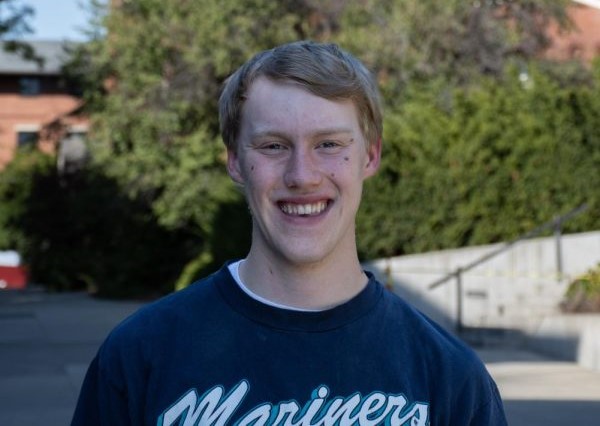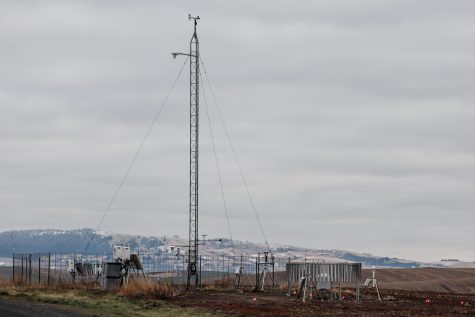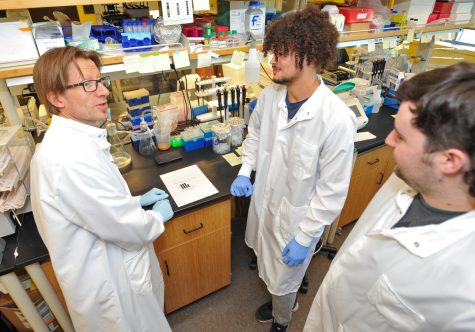Jewett Observatory introduces public to other worlds
Facility named after Harvard professor; features unique curved dome, 12-inch lens
The Jewett Observatory is located on Observation Drive.
January 20, 2022
For anyone wanting to get more involved with astronomy in 2022, WSU’s Jewett Observatory will host several open star parties, which allow visitors to use the historic telescope and learn more about the night sky.
The first star party is on April 9, and there will be one every month through October, according to the observatory website.
Quiet connections
Physics associate professor Guy Worthey was hired to manage the observatory in 2001.
The telescope is primarily used for student laboratories rather than serious astronomical research, Worthey said.
“What this telescope is good at … is zooming in on details really well, and the lenses are just perfect [for that],” he said.
The telescope also helps observers tell when stars that look like one to the naked eye are actually two stars, thanks to its excellent lenses, Worthey said.
“It connects you to the cosmos,” he said. “We are part of the universe, and I guess that’s the main goal of the observatory is to teach people that you can be part of this universe. We’re all in this together.”
Worthey said he has always liked space. He switched majors from geology to astronomy at University of Wyoming.
“[That’s] a state with some good skies,” Worthey said.
Worthey said his favorite part of using the observatory is the quiet connection he feels to the night sky.
“When you go up there to warm up the scope, you’re by yourself. It’s all quiet except for a couple of motors running. You’re tuning into the weather … and you’re checking your charts to see what’s up in the night sky,” Worthey said. “I think maybe the anticipation is just a little bit better than the execution of staring through the eyepiece.”
Ian Kleditz, freshman astrophysics major, said he works at the WSU Planetarium and helps at the observatory. His job consists of welcoming people to astronomical events, playing a video and showing a projection of the night sky to illustrate what people might see outside.
Kleditz said he likes to give his own speeches on the topics covered during the events. He recalls giving a speech about dark energy and universal expansion at a planetarium event last fall.
“Most of the knowledge I know was just through self-learning,” Kleditz said. “A lot of the stuff that comes with the sky movement I learned through using telescopes and doing astrophotography.”
Kleditz said his earliest memory of his interest in astronomy was when he had to choose a book from the school library in fifth grade. He chose a book about basic astronomy and began asking his father, who was an astrophysics major in college, lots of questions.
Throughout the college admissions process, Kleditz said he knew he wanted to study astrophysics. He applied to both University of Washington and WSU for their astrophysics programs, but chose WSU because it is more affordable.
He characterized his fascination with astronomy as an example of the overview effect, which is a shift in awareness when one begins to realize the Earth’s size relative to the rest of the universe. It usually describes what astronauts feel when they first see the Earth from space, Kleditz said.
“Once you learn that you are made up of stardust, you kind of see humanity a little differently beyond that point,” Kleditz said.
Observatory history
The observatory is named after James Richard Jewett, amateur astronomer and Arabic professor at Harvard University. His son, George Jewett, donated money in the 1950s to build the observatory, Worthey said.
The Jewett Observatory stands out from similar facilities because its dome is made of wood, while most are made of metal, Worthey said. A local plywood manufacturer thought it would be an interesting challenge to make curved wood for the project.
The observatory was built around the telescope, which features a 12-inch lens, he said. A WSU professor found a newspaper article about the lens, which was sitting in a bank vault. WSU bought it and scrounged up the rest of the parts.
The telescope pier — the large post that supports the instrument — was meant to have a mechanical clock drive, a mechanism similar to a grandfather clock that moves the telescope as the earth rotates. Builders in the 1950s put in an electric motor instead, Worthey said.
Astronomer Ralph Aeschliman said he helped replace the telescope’s focuser in the early 2000s. Previously, visitors had to get down on their hands and knees to look at objects high in the sky; now, they can bend over the eyepiece at a 90-degree angle.
Aeschliman also cleaned the objective lens and washed the whole telescope, which had not been done in years. It is important to keep the telescope in good condition to preserve its history, he said.
Light pollution
Light pollution can limit views at the observatory. Worthey said he has a deal with the managers of the nearby greenhouses to turn off the lights after 10 p.m. However, parking lot lights can still make it hard to see stars.
“There is no reason why the Milky Way couldn’t be entirely visible within the city limits. All it would require is putting some hoods over street light … then you wouldn’t have to go anywhere to observe the sky,” Kleditz said. “We live in the Milky Way, people should be able to see it at least once.”
Editor’s note: This article has been updated to correct factual errors about Ian Kleditz’s planetarium presentation.























